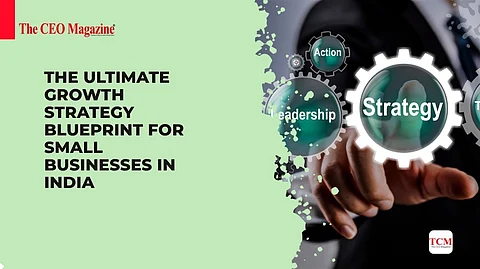
- News
- Women
- Magazine
- IndustryIndustry
- InsightsInsights
- Success Stories
- PublishPublish
- ContactContact
- Media KitMedia Kit

Let me ask you something straight up —
What’s stopping your small business from becoming a big one?
If you’re a founder, entrepreneur, or business owner in India, chances are you’ve asked yourself this many times. I’ve been there. And trust me, you’re not alone.
In a country that adds more than 75,000 startups every year, and with MSMEs contributing nearly 30% of India’s GDP, the potential is massive — but so is the competition.
That’s why today, I’m handing you something invaluable:
A proven blueprint to grow your small business in India — without burning out or breaking the bank.
Whether you run a local services business in Pune or a D2C brand out of Delhi, these strategies are practical, actionable, and tailored for Indian entrepreneurs just like you.
Having goals is great. But without a systematic growth strategy, most small businesses get stuck in survival mode.
Here’s what I’ve learned working with dozens of SMEs and startup founders:
Growth is not an outcome. It’s a process.
And like every great process, it needs a blueprint.
Before you scale, ask: Why should customers choose us over anyone else?
Define your USP (Unique Selling Proposition): Is it speed, price, quality, convenience?
Talk to your customers: Their feedback often reveals your true differentiator.
Avoid trying to be everything to everyone. Niche is your friend.
Example:
Paper Boat didn’t try to be another cold drink. It sold nostalgia — and that story powered its growth across India.
Many small businesses still rely entirely on word-of-mouth. That’s great — but not scalable.
It’s time to go from Lajpat Nagar-famous to India-known.
Set up Google Business Profile to dominate local search.
Build a mobile-friendly website (don’t overcomplicate it).
List on platforms like IndiaMART, Justdial, Amazon, or Meesho depending on your product.
Pro Tip: Use TheCEO.in’s guide to SME digitisation to accelerate this transition.
Think you need lakhs to market effectively? Not anymore.
Here’s what works without a big budget:
WhatsApp Business: Great for promotions, cart recovery, and customer support.
Instagram Reels & YouTube Shorts: If you’re not using short video, you’re missing free reach.
Email marketing: Still one of the highest ROI tools. Start simple with tools like Mailchimp or Zoho.
“Content is fire, social media is gasoline.”
Jay Baer
Use local language, humor, festivals, and culture to make content that connects.
A few sales reps won't scale your revenue. What you need is a repeatable sales system.
Lead generation funnel: Start with a free offer, discount, or demo to attract leads.
CRM tools: Use affordable options like Zoho CRM or HubSpot Free.
Sales scripts and SOPs: Your best salespeople should train your process — not just people.
Real-World Example:
One of our featured SME founders, Ankita Mehra of CraftoIndia, tripled her monthly orders in 6 months simply by implementing a 3-step WhatsApp sales funnel for her home decor line.
Do you know your repeat customer rate?
Because keeping an existing customer is 5x cheaper than getting a new one.
Loyalty programs: Even simple stamp cards or point-based rewards work wonders.
Post-sale engagement: SMS thank-yous, feedback forms, and product usage tips.
Upsell & Cross-sell: Don’t stop at the first sale. Think: What else do they need next?
“Customer service is the new marketing.” — Derek Sivers
This one’s massively underused — and I’ll be blunt, you’re leaving money on the table if you ignore it.
Startup India: Access to funding, tax exemptions, and easier compliance.
CGTMSE: Credit guarantee for loans without collateral.
Mudra Loans: Microfinance up to ₹10 lakh for small businesses.
SIDBI Schemes: Tailored for manufacturing and service-based businesses.
Visit msme.gov.in or your local DIC (District Industries Centre) for support.
Not all growth has to come from you alone.
Smart founders ask: Who already has access to my audience?
Then they partner with them.
Influencer tie-ups with micro-creators in your niche.
Co-branded campaigns with complementary brands.
Referral partnerships with other businesses (e.g., accountants, trainers, consultants).
Example:
A fitness gear startup I advised in Mumbai grew by 20% month-on-month just by partnering with local gyms on bundled offers.
When you're growing, the temptation is to do everything yourself. That’s a trap.
Here’s my mantra:
Automate. Delegate. Eliminate.
Start with generalists who can wear multiple hats.
Document everything — from onboarding to marketing to sales.
Use freelancers and SaaS for non-core activities: accounting, design, digital marketing, etc.
Likes don’t pay the bills.
Instead, track metrics that drive revenue and retention.
Monthly revenue growth rate
Customer acquisition cost (CAC)
Customer lifetime value (CLTV)
Repeat purchase rate
Conversion rates (site visits to sales)
Use simple tools like Google Analytics, Zoho Analytics, or even Excel to begin.
Here’s the secret no one tells you:
Real growth comes from patience + systems.
It’s tempting to chase trends, copy big brands, or burn money on ads. But what works — and lasts — is consistency in execution.
Ask yourself:
Are we building processes that can run without me?
What would my business look like with 5x more customers tomorrow?
What will we be known for in 5 years?
Because growth isn't just about doing more.
It's about doing better, smarter, and more aligned with your vision.
India is the place to build right now. Consumption is booming. Infrastructure is improving. Digital penetration is rising every month.
If you’ve built something people love — now’s the time to scale it.
And this growth blueprint?
It’s not theoretical. It’s a playbook I’ve seen work with small businesses from Surat to Hyderabad, from solopreneurs to 50-person companies.
Start with one strategy. Build momentum.
Then stack your wins.
You’ve got this.
Found this helpful? Bookmark it, share it with your team, or send it to a fellow business owner.
Follow us on Google News
